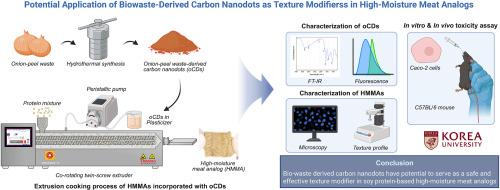Unveiling the utilization of biowaste-derived carbon nanodots as texture modifiers in extrusion-cooked soy-protein-based high-moisture meat analogs
IF 11
1区 农林科学
Q1 CHEMISTRY, APPLIED
引用次数: 0
Abstract
In this study, carbon nanodots (CDs) were synthesized from onion-peel waste as a natural carbon precursor. The CDs were used as plasticizers during the extrusion cooking of high-moisture meat analogs (HMMAs), and their potential as texture modifiers was evaluated. Onion-peel waste-derived carbon nanodots (oCDs) and oCD-incorporated meat analogs were systematically characterized along with comprehensive toxicity assays both in vitro and in vivo to determine their safety as food ingredients. The synthesized oCDs exhibited an average diameter of 4.61 nm, emitting blue fluorescence with diverse surface functional groups. In vitro cytotoxicity assays against Caco-2 cells showed 87.98 % viability after 48 h at the maximum concentration (1000 μg/mL), confirming the low cytotoxicity of the oCDs. Furthermore, in vivo studies in C57BL/6 mice demonstrated no significant differences (P ≥ 0.05) in kidney or liver weight or related biomarkers, even at a high dose (20 mg/kg), further supporting their biocompatibility. The synthesized oCDs were then incorporated into a plasticizer during the high-moisture extrusion of soy-based meat analogs. Compared to the control group, which was only supplied with water as the plasticizer, the oCD-incorporated meat analogs exhibited a higher moisture content and water-holding capacity. Moreover, texture-profile analysis revealed that the HMMAs softened with increasing oCDs concentration, whereas adhesiveness increased (P < 0.05), highlighting the potential of oCDs as texture modifiers for the extrusion processing of HMMAs. In conclusion, based on comprehensive toxicity assessments and physicochemical characterization, this study revealed the potential use of biowaste-derived CDs as safe and effective colorants and texture modifiers for HMMAs.

揭示了利用生物废物衍生的碳纳米点作为挤压煮熟的基于大豆蛋白的高水分肉类类似物的质地改进剂
本研究以洋葱皮废料为原料合成了碳纳米点(CDs)。在高水分肉类类似物(hmma)的挤压蒸煮过程中,将CDs用作增塑剂,并对其作为质地调节剂的潜力进行了评价。本文对洋葱皮废弃物衍生的碳纳米点(oCDs)和含ocd的肉类类似物进行了系统表征,并进行了体外和体内综合毒性试验,以确定其作为食品原料的安全性。合成的oCDs平均直径为4.61 nm,可发出具有不同表面官能团的蓝色荧光。体外对Caco-2细胞进行细胞毒实验,在最大浓度(1000 μg/mL)下,48 h后细胞存活率为87.98%,证实了oCDs的低细胞毒作用。此外,在C57BL/6小鼠体内研究表明,即使在高剂量(20 mg/kg)下,肾脏或肝脏重量或相关生物标志物也没有显著差异(P≥0.05),进一步支持了它们的生物相容性。在高水分挤压大豆基肉类类似物的过程中,将合成的oCDs加入增塑剂中。与只添加水作为增塑剂的对照组相比,添加ocd的肉类似物具有更高的水分含量和保水能力。此外,纹理-轮廓分析显示,随着oCDs浓度的增加,hmma软化,而黏附性增加(P < 0.05),突出了oCDs作为hmma挤出加工纹理改进剂的潜力。综上所述,基于综合毒性评估和物理化学表征,本研究揭示了生物废物来源的cd作为hmma安全有效的着色剂和质地调节剂的潜力。
本文章由计算机程序翻译,如有差异,请以英文原文为准。
求助全文
约1分钟内获得全文
求助全文
来源期刊

Food Hydrocolloids
工程技术-食品科技
CiteScore
19.90
自引率
14.00%
发文量
871
审稿时长
37 days
期刊介绍:
Food Hydrocolloids publishes original and innovative research focused on the characterization, functional properties, and applications of hydrocolloid materials used in food products. These hydrocolloids, defined as polysaccharides and proteins of commercial importance, are added to control aspects such as texture, stability, rheology, and sensory properties. The research's primary emphasis should be on the hydrocolloids themselves, with thorough descriptions of their source, nature, and physicochemical characteristics. Manuscripts are expected to clearly outline specific aims and objectives, include a fundamental discussion of research findings at the molecular level, and address the significance of the results. Studies on hydrocolloids in complex formulations should concentrate on their overall properties and mechanisms of action, while simple formulation development studies may not be considered for publication.
The main areas of interest are:
-Chemical and physicochemical characterisation
Thermal properties including glass transitions and conformational changes-
Rheological properties including viscosity, viscoelastic properties and gelation behaviour-
The influence on organoleptic properties-
Interfacial properties including stabilisation of dispersions, emulsions and foams-
Film forming properties with application to edible films and active packaging-
Encapsulation and controlled release of active compounds-
The influence on health including their role as dietary fibre-
Manipulation of hydrocolloid structure and functionality through chemical, biochemical and physical processes-
New hydrocolloids and hydrocolloid sources of commercial potential.
The Journal also publishes Review articles that provide an overview of the latest developments in topics of specific interest to researchers in this field of activity.
 求助内容:
求助内容: 应助结果提醒方式:
应助结果提醒方式:


